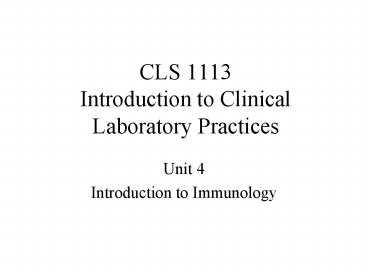CLS 1113 Introduction to Clinical Laboratory Practices PowerPoint PPT Presentation
1 / 16
Title: CLS 1113 Introduction to Clinical Laboratory Practices
1
CLS 1113Introduction to Clinical Laboratory
Practices
- Unit 4
- Introduction to Immunology
2
Immunology
- Immunology
- Study of the molecules, cells, organs, and
systems responsible for the recognition and
disposal of foreign (nonself) material - Study of the MECHANISMS that protect an
individual from injury from - Exogenous microorganisms bacteria, fungi,
viruses - Exogenous chemicals pollen, poison ivy, etc.
- Endogenous cells malignant or senescent cells
- IMMUNE RESPONSE Broad range of defense
mechanisms including inflammation, phagocytosis,
antibody synthesis, etc.
3
Serology
- Serology the study of the non-cellular
components of the blood (serum). - Antibody production and reactivity
- Complement
4
Natural Immunity
- Innate or Inborn immunity
- Non specific
- External Defenses
- Skin, acid in sweat, mucus membranes, cilia in
respiratory tract, normal flora - Internal Defenses
- Non-specific cellular responses
- Cells and soluble factors
5
Acquired Immunity
- Active
- Allows the body to Recognize, Remember and
Respond to a specific stimulus. - Example Your Hepatitis B shots (You were give
three doses of attenuated Hep. B virus your body
recognized it as foreign and produced an
anti-hepatitis B antibody.) - Passive
- Antibody mediated immunity received from another
source - Example A mothers breast milk has antibody that
the baby uses until he/she can produce their own.
- Example A gamma (immune) globulin shot provides
immunity when someone travels over seas, but
their body did nothing to develop the immunity.
6
Cell Mediated vs.Humoral Immunity
- Cell Mediated Immunity
- Form of acquired immunity in which T lymphocytes
recognize and react with a stimulus through
direct cell-to-cell interaction of lymphokines. - Humoral Immunity
- Form of acquired immunity in which B Lymphocytes
and plasma cells produce specific antibodies that
recognize and react to a stimulus.
7
Cellular ImmunityResistance to disease via
cellular elements (Granulocytic) in the blood.
- Neutrophils
- Neutrophils have primary and secondary granules
which contain a wide variety of enzymes. - Neutrophils migrate through vessel walls
(diapedesis) and into tissues when signaled by
chemical messengers (chemotaxins).
8
Cellular Immunity
- Eosinophils
- Red granules
- Eosinophils increase in number in an allergic
reaction or in response to many parasitic
infections.
9
Cellular Immunity
- Basophils
- Blue, large granules containing heparin and
histamine - Heparin is an anticoagulant and histamine
contracts smooth muscle
10
Cellular Immunity
- Monocytes
- Monocytes only make up 4-10 of the circulating
WBCs. - They stay in the blood for a short period of time
and then migrate out into the tissues and become
known as macrophages.
11
Cellular Immunity
- Macrophages
- Macrophages have specific names depending on
their function and particular location. - Lung macrophages are alveolar macrophages.
- Liver macrophages are Kupffer cells.
- Brain macrophages are microglial cells.
- Connective tissue macrophages are histiocytes.
- Monocytes/Macrophages are very important.
- They participate in phagocytosis, anti-tumor
activity, chemical secretion, and antigen
presentation.
12
Phagocytosis
- Phagocytosis
- Greek word meaning cell-eatingThe engulfment
of cells or foreign matter. - Phagocytosis consists of four main steps
- Physical contact of the cell with the foreign
agent - Formation of a phagosome
- Fusion with cellular granules
- Digestion and release of debris to outside of cell
13
(No Transcript)
14
Opsonin
- An opsonin (Greek word meaning prepare for
eating) is a plasma protein that will attach to
a foreign substance and prepare it for
phagocytosis. Types of opsonins include - C-reactive protein, complement, antibodies
15
Inflammation
- Tissue reaction to injury caused by physical or
chemical agents including microorganisms. - The signs of inflammation include
- Redness and Heat
- Mast cells release histamine causing vasodilation
increasing the blood flow to the area - Swelling and Pain
- Increase permeability allows fluids to leak into
the tissues
16
Inflammation
- Major events associated with inflammation
include - Increase blood supply to the affected area
- Increased capillary permeability
- Migration of neutrophils to the affected area
- Migration of macrophages to the affected area

